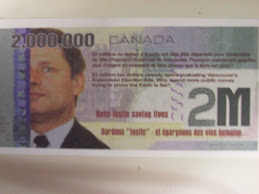Illegal drug study says number of deaths high in Downtown Eastside
CP
723 words
23 August 2007
16:42
The Canadian Press
English
(c) 2007 The Canadian Press. All rights reserved.
VANCOUVER (CP) _ Residents of the poverty-riddled Downtown Eastside have seven times the provincial rate of drug-induced deaths, says a report on drug use in Vancouver.
The report from the Canadian Community Epidemiology Network on Drug Use says deaths from illicit drug use were down in Vancouver and the rest of British Columbia for 2006.
Downtown Eastside residents have a 33 per cent higher death rate than the rest of the province.
The report released Thursday says Vancouver's rate of newly diagnosed hepatitis C cases declined from 2006 and new cases of HIV were down from 2005 in connection to intravenous drug use.
The report also says the volume of ecstasy seized by police in 2005 was more than 40 times that seized in 2002.
``This document provides a unique snapshot of the state of drug use in the city,'' Dr. Jane Buxton, Vancouver site co-ordinator, said in a news release.
``Our hope is that we can empower people with a basic understanding of some of the issues involved so that they can begin to do something about it.''
The group says the study was done to provide policy makers and community leaders with better information to help develop harm reduction and prevention techniques to reduce drug use.
The report found the life expectancy for men in the Downtown Eastside, ``the centre of the injection drug use epidemic in Vancouver,'' is nine years less than for Vancouver overall and three years less for women.
In 2006, there were 131 illicit drug deaths in British Columbia, 42 of them in Vancouver, compared with 146 deaths in B.C. and 46 deaths in Vancouver the previous year.
``There has been a dramatic decline in the number of illicit drug deaths in both Vancouver and B.C. since 1998,'' the report said.
Since 2003, the number and proportion of First Nations people to die from illicit drug use has increased to an average of 17 a year or 10 per cent of deaths.
In the 2001 census, 4.4 per cent of B.C. residents identified themselves as aboriginal.
The Downtown Eastside has a higher rate of tuberculosis than Vancouver or British Columbia.
``Challenges to TB control include unstable housing, mobile populations (including populations moving back and forth between the Downtown Eastside and their rural or reserve home communities), and addictions, co-morbidities and non-compliance to TB treatment.''
Studies in top international journals, including the Lancet and British Medical Journal, suggest Vancouver's safe-injection site, where users are given clean needles to inject their drugs, reduces the chance of people passing along infections such as HIV.
But in order to allow the safe-injection site to operate the federal government must grant an exemption from the Controlled Drugs and Substances Act.
The clinic's current exemption lasts until the end of the year and Health Minister Tony Clement has said he wants comprehensive research on the clinic before giving the further operating approval.
The report says between December 2003 and March 2005 4,764 people used the safe injection site.
Insite ordered 1.2 million sterile needles between April 1, 2006, and Feb. 15, 2007.
``It is important that harm reduction programs attract high-risk users, as the contact presents an opportunity to inform users about safer drug use practices and connect them to health services and drug treatment,'' the report says.
Between March 2004 and August 2005 the drugs most often used at Insite were heroin (40 per cent) and cocaine (28 per cent), as well as morphine, dilaudid, oxycodone, crushed crack cocaine, crystal methamphetamine and Talwin-Ritalin.
A study done before and after the site opened found ``significant reductions in the mean number of injection drug users injecting in public and publicly discarded syringes.''
Vancouver police department statistics indicated there was no increase in drug trafficking, assaults or robberies.
The report said said crack cocaine is one of the commonly used drugs in Vancouver's Downtown Eastside.
``While people of all socio-economic backgrounds use crack people who are homeless, street involved or otherwise living in poverty have high rates of use and experience profound negative health consequences.
``There have been few harm reduction initiatives in Vancouver that specifically target the harms associated with crack use.''
Wednesday, October 17, 2007
Illegal drug study says number of deaths high in Downtown Eastside
Posted by
Jen
at
10:57 AM
![]()
![]()
Subscribe to:
Post Comments (Atom)




No comments:
Post a Comment